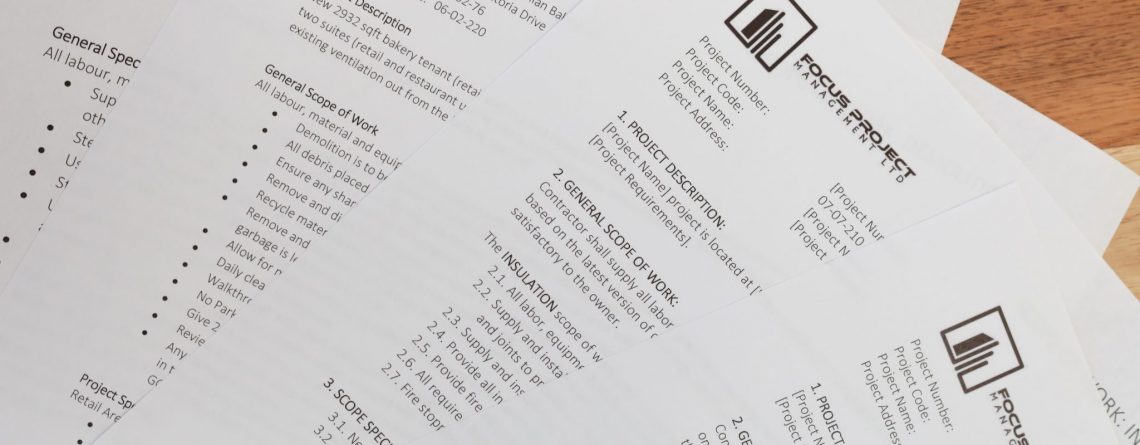Construction Scopes of Work
Construction projects are highly structured and specialized, whether is building, an office, restaurant, or a retail shop, etc. Each Project requires and involves many elements, phases and people that must be precisely coordinated.
Collaborating with people outside the Company on a construction project is very common, and it is very easy for miscommunication or presumptions to occur between different parties, which send the Project off course. For today’s blog we are going to be talking about why a scope of work (SOW) is one of the most important elements for any construction project, having a clear SOW will help avoid confusion, misinterpretations, disputes and will ensure a successful end product.
What is a Scope of Work and why it is important?
A scope of work is a document that a project manager uses to make an agreement with another party or substrate (outside of the team), to communicate and ensure the project deliverables are met. That is why a SOW is one of the most fundamental pieces of a construction contract; it describes in detail what is expected from the contractor, the tasks, obligations, deliverables, deadlines, and responsibilities.
Writing a scope of work is also one of the first things to do on the Project because it provides the necessary information and details to the different parties that allow for fair pricing. A quote or a bid on an application should be as accurate as possible. Without a precise SOW, the Project could face contract discordancy that affects the Project schedule and budget.
If you aim for a smooth, accurate and enjoyable Project, having a precise scope of work will be the best tool for the entire team involved in the Project.
As a construction company, we have written thousands of scopes of work for different projects and different subcontractors and clients. There is no single way to set out the scope of work, but there are some general considerations that should be included:
1. Project Description/Overview: This portion of the scope of work should contain the name of the project or company, address, and a summary of the Project with key objectives or requirements.
Example: [Project Name] project is located at [Project Address]. This project is to [Project Description]. This project requires [Project Requirements].
2. General scope of the work: This part must describe in detail everything that is expected of the contractor with objectives, goal and including all relevant information related to the Project.
* Make sure your expectations and requirements are clear, including who is responsible for the materials, the equipment needed to perform the task and the labour required, etc
Example: Contractor shall supply all labor, material supervision and equipment required to complete the INTERIOR PAINTING scope based on the latest version of drawings, specification, and reports in accordance with all city regulations and satisfactory to the owner.
The INTERIOR PAINTING scope of work shall include but not limited to the following:
2.1. All required full-time supervision, labor, materials and equipment to complete this scope of work complete.
2.2. Surface preparation including removal of dust and dirt from gypsum wallboard and joints prior to paint application.
2.3. All interior and common area painting including:
-As a minimum three (3) coat system, prime and two coats (extra coats may be needed to ensure proper color and coverage is achieved), it’s up to this Trade Contractor to check cover ability of color and product.
– Interior colors as per the Interior Design Specifications.
3. Project Specific/ scope: this portion is more specific and outlines the work that needs to be done including precise tasks, goals, technical requirements, finishes, design and materials.
Example:
3.1. Apply one coat of primer in all walls, doors, door frames and drywall ceiling ready for new painting
3.2. Apply two coats of benjamin moore snow white throughout (except on accent walls, doors and door frames)
3.3. Apply two coats of benjamin moore coventry grey on all accent walls, doors and door frames as per drawing (except one accent wall at reception area).
4. Contractor General Requirements: As the name says, this portion it’s related to what the contractor must have and know to perform the job.
Example: Subcontractor will provide and adhere to the following but not limited to:
4.1. General Liability Insurance of a $5,000,000
4.2. Good standing with WorkSafeBC and provide periodic clearance letters as requested
4.3. All workers must be qualified within their scope of work
4.4. Shall not start construction without a valid trades permit and shall have all work inspected by the municipality having jurisdiction and shall obtain final inspection
5. Project Schedule: Some project managers include the schedule in the same scope of work document, it is not necessary to be part of it, but the schedule is an essential element that you must deliver to your contractor with deadlines, delivery dates, milestones, and completion date.
Some scopes of work might include a section with alternative options, unit rates, worship man, safety rules and warranty. This depends on how specific and clear you want to be.
One of the most important things as a project manager is to clearly understand the drawings to make an accurate scope of work, once this is done, make sure your contractors have access to the drawings, photos and other resources so that they can price their work properly. I will highly recommend taking a site tour with each subtrade, to have more precision and understanding of the work that needs to be done.
Hope this was helpful!


